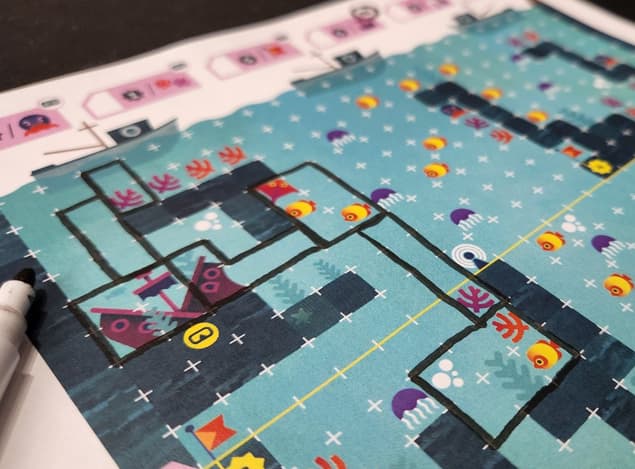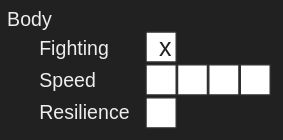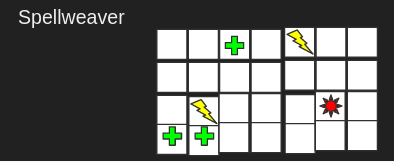Hello! I’m back designing games, and this idea is haunting me:
Making stats, resources and everything into blocky funky shapes. The inspiration is from the board game Aquamarine:

Essentially, both the GM and players would operate with something like this:
Core question:
What’s the minimal set of rules that would make this prototype give me enough info to make things evolve?
Core design ideas:
- Track everything that matters, as players forget or ignore a lot at their disposal
- Spending, earning and exchanging these “tokens” is a way to have structured roleplaying, and make decisions.
- Make use of interesting mathematical patterns (detailed below)
- Everything that’s good about Clocks, but occasionally making use of 2D space
- Play with scale. Zoom in and out from seconds to minutes, hours, days or more. One attack, one battle, one dungeon-delve.
- Create new negotiations and game mechanics on the fly (Flashbacks, Fate Points, Spells, Mutations)
- See what factored into the success or failure of an action, helping narrate an outcome or complications
Just doodling around, I arrived at funky things such as…:
I’m opening a lot more design-space than I can currently cover, so here’s a pile of game mechanics and mathematical relationships I’m floating around:
- Number curves and diminishing returns as a way to play with scale, e.g. 0 mana for a spark (narrative permission), 1 mana for a fire bolt, 2 for a fireball, 4 for a firestorm.
- Other number curves: triangular (1, 1+2, 1+2+3, …), squares (1, 4, 9, …)
- Width and height representing different things
- Several ways to fill in or clear boxes (row or column, contiguous shape, non-adjacent spaces, damage being permanent or even spreading to adjacent boxes, tetraminoes, filling in leftmost/topmost/etc)
- Replenishing or exchanging resources 1-to-X depending on situation (expending 2 boxes of stealth if in heavy armour to remain undetected vs 1 in light, exchanging mana and time 3-for-1 to HP by healing someone)
- Instead of “clearing” boxes, you simply add new ones for XP, both spending XP on interesting things and reaching various milestones
- Spending a resource before a roll to boost it vs a heavier amount after a roll (1 STR for a +1/extra die to hit, or 4 STR for a reroll/grim success)
- Encouraging players to spend by “wasting” regen above the cap or tempting them with extra effects on success
I know, I know, I need a core mechanic or something. I like PBTA’s asymmetrical mechanics, so I’m envisioning the GM as someone who just sets target numbers, narrates, and occasionally fills in boxes or plays with “mods” that add a lot to gameplay.
- 1d10+X vs TN. Clear, 10% increments. Alternatively, d6 pools.
- Some interesting ways to distribute stats and resources, but not as complex as

- Some way to spend and exchange resources to influence rolls or achieve certain effects, with different ratios (1-to-1 or better for specific, spot-on effects like strength for damage, or lockpicks for doors, worse for “stretches” or generica like “rogue stuff” or “magic”
- Some tactile enjoyment of the 2D layout, filling shapes, choosing interesting resources or builds, preparing well for an adventure, pushing their luck.
- Using GM tools to make things more menacing and interesting, like the Tension Pool. The GM gains resources like Spent Time, Heat, Danger, Doom, and whatever, but may expend them with dice.
Will edit as I shape this better, it took a lot to even get out a half-idea like this. Where should I go from here?
Edit:
“Dynamics” that I want to see in the game:
- Spend for good odds of succeeding. Burn things for very good odds. Certainty requires a massive sacrifice. If it’s up to the players how much everything matters (the final blow, stealth, persuasion on a major NPC), I can portray my world more ruthlessly, truthfully, and without a “backup plan” if they fail.
- Well-prepared weirdos. “Can I…use X to do this?” Yes. Especially if you hinted at it in the past. Hexcrawly explorations and whimsical currencies a la Fallen London are welcome.
- Exchanging is roleplaying as much as interpreting a roll or making decisions is. Having a Motivation: Revenge track that nobody else does, is roleplaying.
- Zoom-in and zoom-out. Resolving a fight in 15 minutes is as valid as resolving an entire sidequest in 10, or dungeon-crawl in 5.
- Funky boxes are fun to fill. We play a lot of roll’n’writes. Funky symbols in them are cool. There’s something here. Pray that I don’t replace the boxes with dice, ascending into the THIRD DIMENSION!
Funky ideas
- Designing a “skill tree” with certain symbols on a grid, creating something to look forward to, then filling it in with XP later


